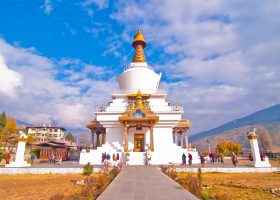Bhutan – Happiness is a place
Bhutan : the only official Buddhist country in the world, a place straight out of the coffee table books with mighty landscapes of Himalayas, calmness and spirituality of monasteries and stupas, powers of the prayers flying in the air, beautiful dzongs and chortens, a land where the rice is red and chilies are main dish and spectacular Tsechus (dance festivals) is no ordinary place but is the last great Himalayan kingdom wrapped in mystery and magic. Important cities : Thimu , Paro , Punakha
Thimphu is the most modern and the capital city of Kingdom of Bhutan is located in a valley in north-west of the country. Thimphu reflects the culture of Bhutan in respect of religion, customs, national dress code, the monastic practices of the monasteries, music, dance and literature. Besides being the seat of government, the city is known for its Buddhist temples. The Tashichho Dzong is a huge fortified monastery and a government palace with golden leaf roofs.
Taschichho Dzong (Fortress) situated on the banks of Wang Chhu River is an impressively large structure, surrounded by well-kept lawns and beautiful gardens. The Dzong has been the seat of the government since 1952 and presently houses the throne room and offices of the king. Taschichho Dzong was built in 1216 AD and is a Buddhist monastery besides being the office of the Government of Bhutan.
National Memorial Chorten (stupa) is one of the most religious stupas in Thimphu. Chorten with its Golden Dome was built in 1974 is an extra ordinary example of Buddhist architecture and artwork with its gorgeous paintings and intricate sculptures.
Buddha Dordenma Statue is one of the largest statues of Buddha. Set on a large meditation hall, the statue is made of bronze and gilded in Gold. It is said to emanate an aura of peace and happiness to the entire world.
Dochula Pass is a mountain pass in snow covered Himalayas between Thimphu and Punaka. There are 108 more smaller stupas (chortens) around the main stupa. The views of Himalayas are mesmerizing from Dochula Pass.
Taktshang Monastery or often called as Tiger’s Nest is the most iconic landmark and religious sites of Bhutan. The monastery in the caves are situated 10 kms north of Paro and needs a trek of 2-3 hours through beautiful , shady pine forest. It was first built in 1692 at a cave where Guru Rimpoche meditated in the 7th century A.D. Legend states that Guru Rimpoche flew to the site atop the back of a tigress and meditated in the cave for 3 years, 3 months, 3 days and 3 hours in order to subdue evil demons residing within it to remove the evils of demons.
Rinpung Dzong or just Paro Dzong is a large Dzong – Buddhist Monastery and Fortress built in 1646 AD. Earlier it was known as Rinchen Pung Dzong literally meaning “fortress on a heap of jewels.” It is one of the finest example of Bhutanese architecture and it contains fourteen shrines. The fortress now houses the office of the district administration and the court including the monk body. The courtyard inside the fortress is used for Paro Tsechu, a festival conducted in the first day of spring. It is one of the most important festivals in Bhutan.
National Museum of Bhutan or Ta Dzong is an ancient watch tower was built in 1649 . Later it was renovated in 1968 and was converted in National Museum. The building in a conch shell has about 2.5 meter thick walls and now houses hundreds of ancient Bhutanese artifacts and artwork including traditional costumes, weaponry and handcrafted implements for daily life of Bhutanese.











